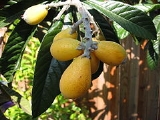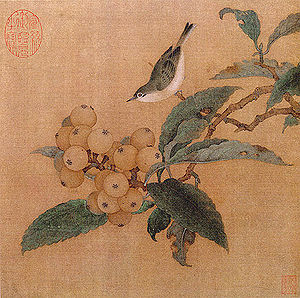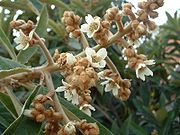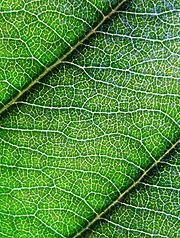
Loquat
Encyclopedia
The loquat Eriobotrya japonica, is a fruit tree in the family Rosaceae
, indigenous to southeastern China
. It was formerly thought to be closely related to the genus Mespilus, and is still sometimes known as the Japanese medlar. It is also known as Japanese plum and as Chinese plum.
large shrub
or small tree
, with a rounded crown, short trunk and woolly new twigs. The tree can grow to 5–10 m (16.4–32.8 ft) tall, but is often smaller, about 3–4 m (9.8–13.1 ft).
The leaves
are alternate, simple, 10–25 cm long, dark green, tough and leathery in texture, with a serrated margin, and densely velvety-hairy below with thick yellow-brown pubescence; the young leaves are also densely pubescent above, but this soon rubs off.
s appear in the autumn or early winter, and the fruits are ripe in late winter or early spring. The flowers are 2 cm diameter, white, with five petals, and produced in stiff panicle
s of three to ten flowers. The flowers have a sweet, heady aroma that can be smelled from a distance.
Loquat fruits, growing in clusters, are oval, rounded or pear-shaped, 3–5 cm long, with a smooth or downy, yellow or orange, sometimes red-blushed skin. The succulent, tangy flesh is white, yellow or orange and sweet to subacid or acid, depending on the cultivar
. Each fruit contains five ovules, of which one to five mature into large brown seeds. The skin, though thin, can be peeled off manually if the fruit is ripe.
The fruits are the sweetest when soft and orange. The flavor is a mix of peach, citrus and mild mango.
 The loquat is originally from southeastern China. It was introduced into Japan
The loquat is originally from southeastern China. It was introduced into Japan
and became naturalised
there in very early times, and has been cultivated there for over 1,000 years. It has also become naturalised in India
, the whole Mediterranean Basin
, Pakistan
and many other areas. Chinese immigrants are presumed to have carried the loquat to Hawaii
.
The loquat was often mentioned in ancient Chinese literature, such as the poems of Li Bai
. In Portuguese
literature, it is mentioned since before the Age of Discovery
.
, in many aspects, with a high sugar, acid and pectin
content. It is eaten as a fresh fruit and mixes well with other fruits in fresh fruit salads or fruit cups. Firm, slightly immature fruits are best for making pies or tart
s. The fruits are also commonly used to make jam, jelly
, and chutney
, and are often served poached in light syrup
.
In Japan, it is eaten fresh or sometimes canned because the flesh is sweet. However, the waste ratio is 30% or more, due to the size of the seed. Among other things, it is processed to confectionery including jellies and the jam.
Loquats can also be used to make light wine. It is fermented into a fruit wine, sometimes using just the crystal sugar and white liquor. Lemon or lemon zest
is often paired with the wine because the fruit has very low acidity. Aficionados also enjoy a sake made exclusively from the seed, which has an aroma much like apricot kernel. Due to the presence of cyanogenic glycosides, bulk consumption may pose a risk of cyanide poisonings.
Nutrition
The loquat is low in saturated fat and sodium, and is high in vitamin A, dietary fiber, potassium, and manganese.
Like most related plants, the seed
s (pips) and young leaves of the plant are slightly poisonous, containing small amounts of cyanogenic glycosides (including amygdalin
) which release cyanide
when digested, though the low concentration and bitter flavour normally prevents enough being eaten to cause harm.

; literally "loquat paste"), it acts as a demulcent
and an expectorant, as well as to soothe the digestive and respiratory systems.
Eaten in quantity, loquats have a gentle but noticeable sedative effect, with effects lasting up to 24 hours.
There are many named cultivar
s, with orange or white flesh. Some cultivars are intended for home-growing, where the flowers open gradually, and thus the fruit also ripens gradually, compared to the commercially grown species where the flowers open almost simultaneously, and the whole tree's fruit also ripens together.
Japan
is the leading producer of loquats followed by Israel and then Brazil.
 The name loquat derives from lou4 gwat1, the Cantonese pronunciation of its old classical Chinese name .
The name loquat derives from lou4 gwat1, the Cantonese pronunciation of its old classical Chinese name .
Rosaceae
Rosaceae are a medium-sized family of flowering plants, including about 2830 species in 95 genera. The name is derived from the type genus Rosa. Among the largest genera are Alchemilla , Sorbus , Crataegus , Cotoneaster , and Rubus...
, indigenous to southeastern China
China
Chinese civilization may refer to:* China for more general discussion of the country.* Chinese culture* Greater China, the transnational community of ethnic Chinese.* History of China* Sinosphere, the area historically affected by Chinese culture...
. It was formerly thought to be closely related to the genus Mespilus, and is still sometimes known as the Japanese medlar. It is also known as Japanese plum and as Chinese plum.
Description
Eriobotrya japonica is an evergreenEvergreen
In botany, an evergreen plant is a plant that has leaves in all seasons. This contrasts with deciduous plants, which completely lose their foliage during the winter or dry season.There are many different kinds of evergreen plants, both trees and shrubs...
large shrub
Shrub
A shrub or bush is distinguished from a tree by its multiple stems and shorter height, usually under 5–6 m tall. A large number of plants may become either shrubs or trees, depending on the growing conditions they experience...
or small tree
Tree
A tree is a perennial woody plant. It is most often defined as a woody plant that has many secondary branches supported clear of the ground on a single main stem or trunk with clear apical dominance. A minimum height specification at maturity is cited by some authors, varying from 3 m to...
, with a rounded crown, short trunk and woolly new twigs. The tree can grow to 5–10 m (16.4–32.8 ft) tall, but is often smaller, about 3–4 m (9.8–13.1 ft).
The leaves
Leaf
A leaf is an organ of a vascular plant, as defined in botanical terms, and in particular in plant morphology. Foliage is a mass noun that refers to leaves as a feature of plants....
are alternate, simple, 10–25 cm long, dark green, tough and leathery in texture, with a serrated margin, and densely velvety-hairy below with thick yellow-brown pubescence; the young leaves are also densely pubescent above, but this soon rubs off.
Fruit
Loquats are unusual among fruit trees in that the flowerFlower
A flower, sometimes known as a bloom or blossom, is the reproductive structure found in flowering plants . The biological function of a flower is to effect reproduction, usually by providing a mechanism for the union of sperm with eggs...
s appear in the autumn or early winter, and the fruits are ripe in late winter or early spring. The flowers are 2 cm diameter, white, with five petals, and produced in stiff panicle
Panicle
A panicle is a compound raceme, a loose, much-branched indeterminate inflorescence with pedicellate flowers attached along the secondary branches; in other words, a branched cluster of flowers in which the branches are racemes....
s of three to ten flowers. The flowers have a sweet, heady aroma that can be smelled from a distance.
Loquat fruits, growing in clusters, are oval, rounded or pear-shaped, 3–5 cm long, with a smooth or downy, yellow or orange, sometimes red-blushed skin. The succulent, tangy flesh is white, yellow or orange and sweet to subacid or acid, depending on the cultivar
Cultivar
A cultivar'Cultivar has two meanings as explained under Formal definition. When used in reference to a taxon, the word does not apply to an individual plant but to all those plants sharing the unique characteristics that define the cultivar. is a plant or group of plants selected for desirable...
. Each fruit contains five ovules, of which one to five mature into large brown seeds. The skin, though thin, can be peeled off manually if the fruit is ripe.
The fruits are the sweetest when soft and orange. The flavor is a mix of peach, citrus and mild mango.
History

Japan
Japan is an island nation in East Asia. Located in the Pacific Ocean, it lies to the east of the Sea of Japan, China, North Korea, South Korea and Russia, stretching from the Sea of Okhotsk in the north to the East China Sea and Taiwan in the south...
and became naturalised
Naturalisation (biology)
In biology, naturalisation is any process by which a non-native organism spreads into the wild and its reproduction is sufficient to maintain its population. Such populations are said to be naturalised....
there in very early times, and has been cultivated there for over 1,000 years. It has also become naturalised in India
India
India , officially the Republic of India , is a country in South Asia. It is the seventh-largest country by geographical area, the second-most populous country with over 1.2 billion people, and the most populous democracy in the world...
, the whole Mediterranean Basin
Mediterranean Basin
In biogeography, the Mediterranean Basin refers to the lands around the Mediterranean Sea that have a Mediterranean climate, with mild, rainy winters and hot, dry summers, which supports characteristic Mediterranean forests, woodlands, and scrub vegetation...
, Pakistan
Pakistan
Pakistan , officially the Islamic Republic of Pakistan is a sovereign state in South Asia. It has a coastline along the Arabian Sea and the Gulf of Oman in the south and is bordered by Afghanistan and Iran in the west, India in the east and China in the far northeast. In the north, Tajikistan...
and many other areas. Chinese immigrants are presumed to have carried the loquat to Hawaii
Hawaii
Hawaii is the newest of the 50 U.S. states , and is the only U.S. state made up entirely of islands. It is the northernmost island group in Polynesia, occupying most of an archipelago in the central Pacific Ocean, southwest of the continental United States, southeast of Japan, and northeast of...
.
The loquat was often mentioned in ancient Chinese literature, such as the poems of Li Bai
Li Bai
Li Bai , also known in the West by various other transliterations, especially Li Po, was a major Chinese poet of the Tang dynasty poetry period. He has been regarded as one of the greatest poets in China's Tang period, which is often called China's "golden age" of poetry. Around a thousand existing...
. In Portuguese
Portugal
Portugal , officially the Portuguese Republic is a country situated in southwestern Europe on the Iberian Peninsula. Portugal is the westernmost country of Europe, and is bordered by the Atlantic Ocean to the West and South and by Spain to the North and East. The Atlantic archipelagos of the...
literature, it is mentioned since before the Age of Discovery
Age of Discovery
The Age of Discovery, also known as the Age of Exploration and the Great Navigations , was a period in history starting in the early 15th century and continuing into the early 17th century during which Europeans engaged in intensive exploration of the world, establishing direct contacts with...
.
Culinary
The loquat is comparable with its distant relative, the appleApple
The apple is the pomaceous fruit of the apple tree, species Malus domestica in the rose family . It is one of the most widely cultivated tree fruits, and the most widely known of the many members of genus Malus that are used by humans. Apple grow on small, deciduous trees that blossom in the spring...
, in many aspects, with a high sugar, acid and pectin
Pectin
Pectin is a structural heteropolysaccharide contained in the primary cell walls of terrestrial plants. It was first isolated and described in 1825 by Henri Braconnot...
content. It is eaten as a fresh fruit and mixes well with other fruits in fresh fruit salads or fruit cups. Firm, slightly immature fruits are best for making pies or tart
Tart
A tart is a baked dish consisting of a filling over a pastry base with an open top not covered with pastry. The pastry is usually shortcrust pastry; the filling may be sweet or savoury, though modern tarts are usually fruit-based, sometimes with custard....
s. The fruits are also commonly used to make jam, jelly
Fruit preserves
Fruit preserves are preparations of fruits and sugar, often canned or sealed for long-term storage. The preparation of fruit preserves today often involves adding commercial or natural pectin as a gelling agent, although sugar or honey may be used, as well. Prior to World War II, fruit preserve...
, and chutney
Chutney
Chutney is a a condiment used in South Asian cuisine that usually contains a spice and vegetable mix.Chutneys are wet or dry, having a coarse to fine texture. The Anglo-Indian loan word refers to fresh and pickled preparations indiscriminately, with preserves often sweetened. At least several...
, and are often served poached in light syrup
Syrup
In cooking, a syrup is a thick, viscous liquid consisting primarily of a solution of sugar in water, containing a large amount of dissolved sugars but showing little tendency to deposit crystals...
.
In Japan, it is eaten fresh or sometimes canned because the flesh is sweet. However, the waste ratio is 30% or more, due to the size of the seed. Among other things, it is processed to confectionery including jellies and the jam.
Loquats can also be used to make light wine. It is fermented into a fruit wine, sometimes using just the crystal sugar and white liquor. Lemon or lemon zest
Zest (ingredient)
Zest is a food ingredient that is prepared by scraping or cutting from the outer, colorful skin of citrus fruits such as lemon, orange, citron, and lime. Zest is used to add flavor to foods....
is often paired with the wine because the fruit has very low acidity. Aficionados also enjoy a sake made exclusively from the seed, which has an aroma much like apricot kernel. Due to the presence of cyanogenic glycosides, bulk consumption may pose a risk of cyanide poisonings.
Nutrition
The loquat is low in saturated fat and sodium, and is high in vitamin A, dietary fiber, potassium, and manganese.
Like most related plants, the seed
Seed
A seed is a small embryonic plant enclosed in a covering called the seed coat, usually with some stored food. It is the product of the ripened ovule of gymnosperm and angiosperm plants which occurs after fertilization and some growth within the mother plant...
s (pips) and young leaves of the plant are slightly poisonous, containing small amounts of cyanogenic glycosides (including amygdalin
Amygdalin
Amygdalin , C20H27NO11, is a glycoside initially isolated from the seeds of the tree Prunus dulcis, also known as bitter almonds, by Pierre-Jean Robiquet...
) which release cyanide
Cyanide
A cyanide is a chemical compound that contains the cyano group, -C≡N, which consists of a carbon atom triple-bonded to a nitrogen atom. Cyanides most commonly refer to salts of the anion CN−. Most cyanides are highly toxic....
when digested, though the low concentration and bitter flavour normally prevents enough being eaten to cause harm.

Medicinal
Loquat syrup is used in Chinese medicine for soothing the throat and is a popular ingredient for cough drops. The leaves, combined with other ingredients and known as pipa gao (枇杷膏; pinyin: pípágāoNin Jiom Pei Pa Koa
King-to Nin Jiom Pei Pa Koa or more commonly, Nin Jiom Pei Pa Koa or simply Pei Pa Koa is a Traditional Chinese natural herbal remedy used for the relief of sore throat, coughs, hoarseness, and loss of voice. It is a throat demulcent and expectorant. Today, it is manufactured and sold by Nin...
; literally "loquat paste"), it acts as a demulcent
Demulcent
A demulcent is an agent that forms a soothing film over a mucous membrane, relieving minor pain and inflammation of the membrane. Demulcents are sometimes referred to as mucoprotective agents. Demulcents such as pectin, glycerin, honey, and syrup are common ingredients in cough mixtures...
and an expectorant, as well as to soothe the digestive and respiratory systems.
Eaten in quantity, loquats have a gentle but noticeable sedative effect, with effects lasting up to 24 hours.
Cultivation
The Loquat is easy to grow in subtropical to mild temperate climates where it is often grown as an ornamental tree, and second for its delicious fruit. The boldly textured foliage adds a tropical look to gardens, contrasting well with many other plants.There are many named cultivar
Cultivar
A cultivar'Cultivar has two meanings as explained under Formal definition. When used in reference to a taxon, the word does not apply to an individual plant but to all those plants sharing the unique characteristics that define the cultivar. is a plant or group of plants selected for desirable...
s, with orange or white flesh. Some cultivars are intended for home-growing, where the flowers open gradually, and thus the fruit also ripens gradually, compared to the commercially grown species where the flowers open almost simultaneously, and the whole tree's fruit also ripens together.
Japan
Japan
Japan is an island nation in East Asia. Located in the Pacific Ocean, it lies to the east of the Sea of Japan, China, North Korea, South Korea and Russia, stretching from the Sea of Okhotsk in the north to the East China Sea and Taiwan in the south...
is the leading producer of loquats followed by Israel and then Brazil.
Etymology

See also
- KumquatKumquatCumquats or kumquats are a group of small fruit-bearing trees in the flowering plant family Rutaceae, either forming the genus Fortunella, or placed within Citrus sensu lato...
(Although Kumquats are not related botanically to Loquats, the two names share an origin in their old Chinese names.) - Coppertone loquat, a hybrid of Eriobotrya deflexaEriobotrya deflexaEriobotrya deflexa is a tree native to Guangdong, Hainan, Taiwan, and South Vietnam.-Coppertone Loquat:The Coppertone Loquat is a hybrid of Eriobotrya deflexa and Indian Hawthorn and is a popular shrub in the Southern United States and California....
(synonym: Photinia deflexa) and Rhaphiolepis indicaRhaphiolepis indicaIndian Hawthorn or India Hawthorn is an evergreen shrub in the family Rosaceae. The species is from southern China, grown for its decorative pink flowers, and is popular in bonsai culture. The fruit is edible when cooked, and can be used to make jam.Indian Hawthorn is a mainstay horticultural...

